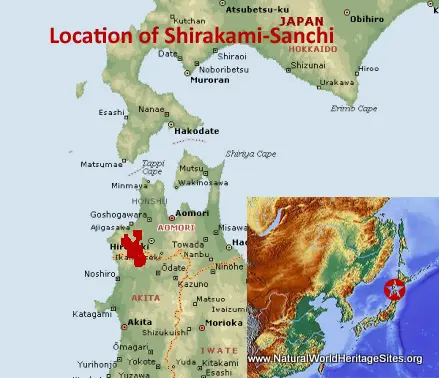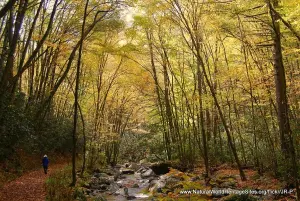EXPLORE Shirakami-Sanchi with this slideshow, check the location map and get all the facts and information below.
For slideshow description see right or scroll down (mobile). Click to view slideshow
Location and Values: Shirakami-Sanchi is located in the mountains of northern Honshu, protecting the largest remaining tract of forest dominated by Siebold’s beech, a tree species endemic to Japan. The forest covers a third of the Shirakami mountain range and is maintained in a pristine wilderness condition. It is the largest and most intact relic of a type of beech forest that once covered most of northern Honshu, and an outstanding example of ongoing processes in the evolution of this type of cool-temperate forest under changing climatic conditions. The beech trees that dominate the forest canopy are associated with a complete suite of associated plant and animal species, some of which are unable to survive in smaller remnant patches of beech and commercial forests elsewhere. Some species that survive in the virgin wilderness at Shirakami-Sanchi include Japanese black bear, Japanese macaque, Japanese serow, black woodpecker and understorey plants such as the dwarf bamboo, Sasa kurilensis.
Conservation Status and Prospects. According to IUCN’s Conservation Outlook Assessment (2020) the conservation status of Shirakami-Sanchi is ‘good’. The IUCN report notes that the site is well protected by strong legislation, an effective management regime, and local community reverence for the area’s forests. The only significant long-term threats to Shirakami-Sanchi are posed by climate change and the potential damage to forest regeneration caused by a proliferation of sika deer. The world heritage site is relatively small and its ecological integrity depends to some extent on integrated management with the neighbouring forests which help sustain viable populations of some of the larger mammals (such as black bear and serow) and a threatened species of bird (the black woodpecker). There is a need to ensure continued integration and forest protection within the wider landscape, with possible future extension of the area under strict protection. Future management of the site could also benefit from greater involvement by local communities, particularly the Matagi people who are traditional forest users with strong cultural links to the site.
Links:
Google Earth
Official UNESCO Site Details
IUCN Conservation Outlook
UNEP-WCMC Site Description
Birdlife IBA
Slideshow description
The slideshow ‘tells the story’ of Shirakami-Sanchi with a portfolio of photos that illustrate the landscape features of this outstanding place, together with some of the typical plants and animals. It starts with a photo of the visitor centre and some general views of the mountainous landscape, forest interior, black woodpecker and one of the many waterfalls. A series of photos of Japanese macaques is followed by close-ups of some of the typical plants of the forest floor in flower, and a couple of images of black bears and the claw marks they typical leave on the bark of mature trees. The final part of the slideshow features a series of photos of Japanese serow, and additional images of the beech forest interior.
The following Flickr photographers and other sources are acknowledged with thanks for their contributions to this slideshow: merec0, 8-og, C.K.Tse, Wall Boat, Martha deJong Lantink, coniferconifer, Masashi Mochida, Science News, japantimes.co.jp, ken, Hiro Hitake, georgep008, photos mweber, Tangerinaok, Takumi Shimada, Josh More and Psymeg & Chooch.
Factfile
Website Category:
Temperate & Boreal Forests
Area: 170 km2
Inscribed: 1993
UNESCO Criterion:
- Ecological processes (ix);





